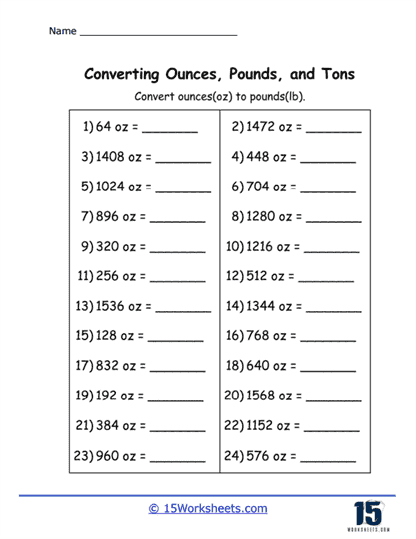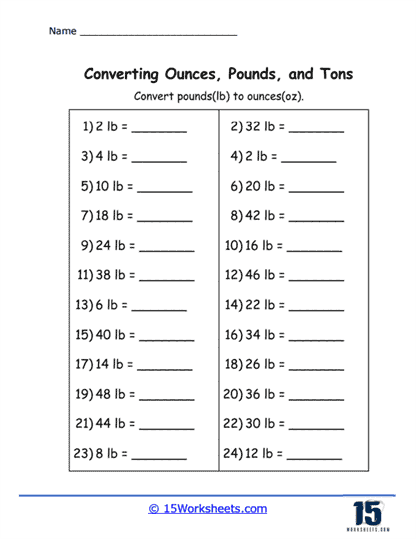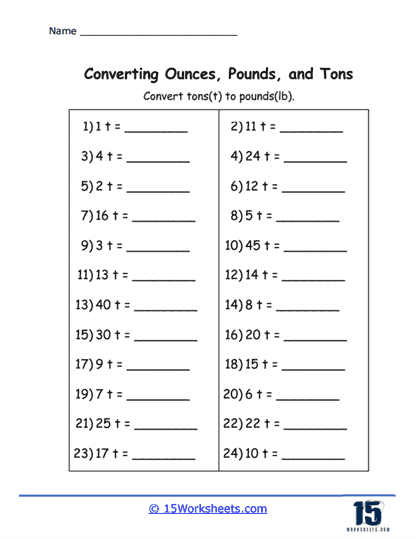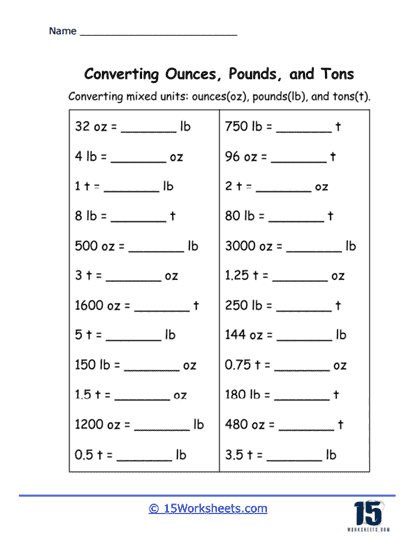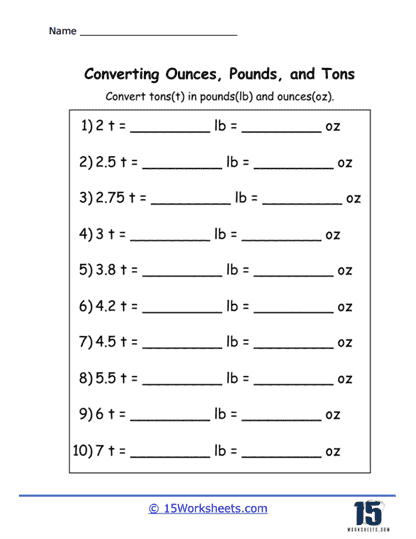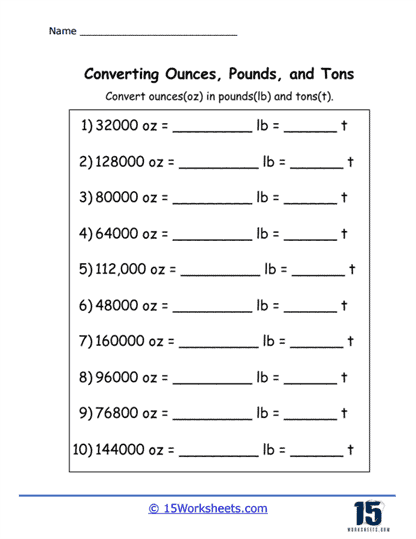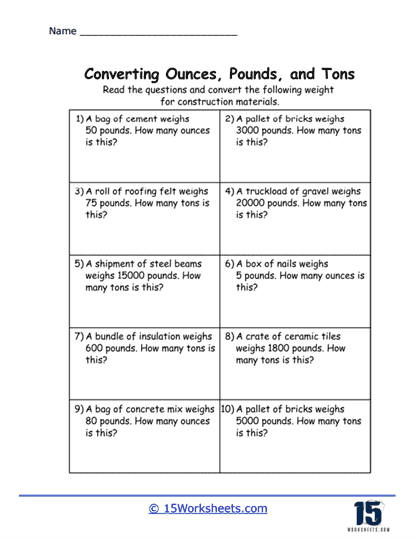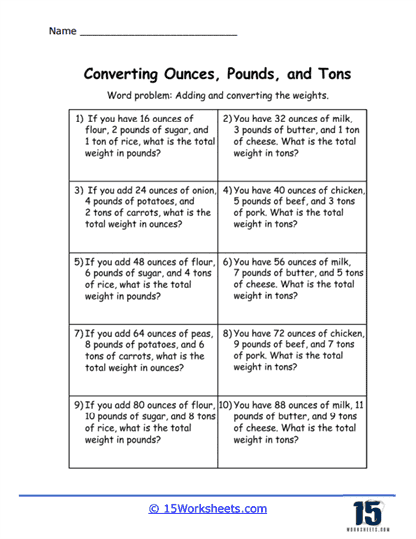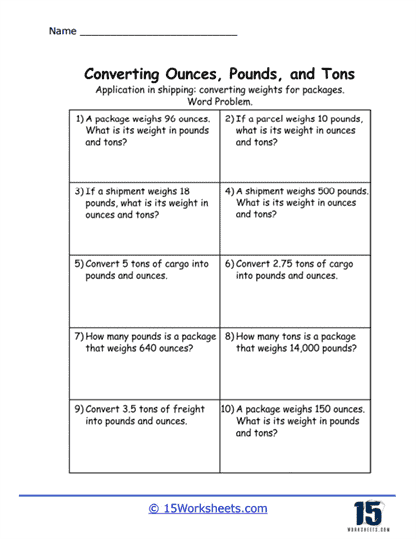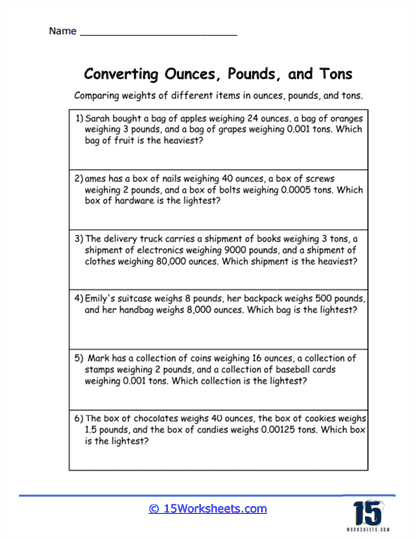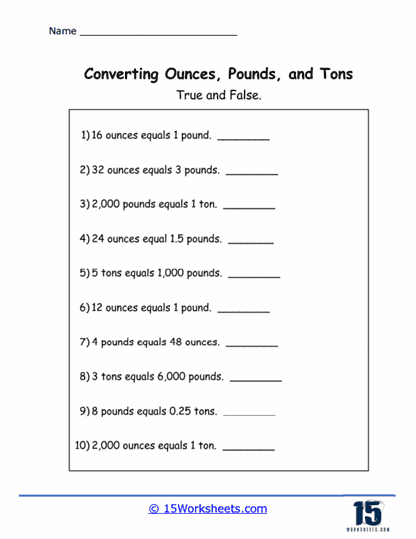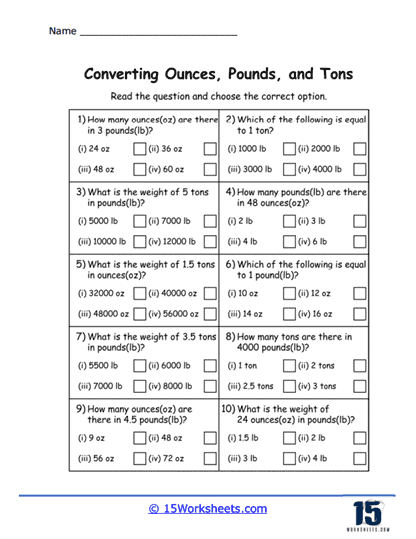Ounces, Pounds, and Tons Worksheets
About These 15 Worksheets
Ounces, pounds, and tons worksheets are educational tools designed to teach students about the U.S. customary units of weight. These units are crucial for various practical and academic applications, from everyday grocery shopping to scientific calculations in physics and engineering. The primary purpose of these worksheets is to help students understand and convert between ounces, pounds, and tons, facilitating a deeper comprehension of weight measurements and their practical implications.
The worksheets incorporate a variety of exercises aimed at developing students’ skills in handling measurements in ounces, pounds, and tons. These exercises range from simple conversions and word problems to more complex real-world applications and estimation activities. By engaging with these varied tasks, students not only learn the basic conversion factors, such as 16 ounces in a pound and 2,000 pounds in a ton, but also how to apply this knowledge in different contexts.
Conversion Exercises
Conversion exercises are a fundamental component of these worksheets. They require students to convert weights from one unit to another, such as converting ounces to pounds or pounds to tons. These exercises often start with straightforward direct conversions and gradually increase in complexity, incorporating larger numbers or requiring multiple conversion steps. For example, students might be asked to convert 320 ounces to pounds or 3,500 pounds to tons. This practice helps solidify their understanding of the relationships between different units of weight.
Word problems on ounces, pounds, and tons worksheets blend math skills with real-life scenarios, making the exercises more engaging and applicable to everyday situations. These problems might involve scenarios such as calculating the total weight of ingredients needed for a recipe or determining the load capacity of a truck in tons. Through these exercises, students learn to interpret and solve problems that involve weight, enhancing their problem-solving abilities and their ability to think critically about the practical use of measurements.
Estimation Exercises
Estimation exercises challenge students to make educated guesses about the weight of common objects or the total weight of several items combined. For instance, a worksheet might ask students to estimate the weight of a classroom textbook in ounces or the total weight of all the desks in a classroom in pounds. These exercises help students develop a practical sense of weight, improving their ability to gauge and reason about the mass of objects in real-world terms.
Matching and sorting activities in these worksheets often involve matching objects with their approximate weights or sorting a series of items based on their weight from lightest to heaviest. This type of exercise reinforces the understanding of weight as a physical quantity and helps students become more familiar with the concept of scale and comparative weight.
Diagram Labeling
Some worksheets include diagrams of objects with parts that students must label with the correct weights, using the information they have learned about ounces, pounds, and tons. This exercise combines visual learning with practical application, enhancing students’ ability to associate different objects with their respective weights.
Multiple-choice questions test students’ knowledge of weight conversions, unit characteristics, and their applications. These might include questions about the number of ounces in a certain number of pounds or how many pounds are heavier than a specific number of tons. Such questions assess understanding in a straightforward format, providing immediate feedback on students’ comprehension.
Practical measurement tasks may involve activities where students must weigh objects using scales and then record and convert these measurements. This hands-on approach reinforces theoretical knowledge through practical application, making learning more dynamic and memorable.
When Do We Use These Measurement Units In The Real World?
Ounces, pounds, and tons are measurement units predominantly used in the United States and a few other countries that have not fully adopted the metric system. These units are part of the Imperial system (also known as the U.S. customary system) and are primarily used for measuring weight (or mass, technically speaking).
Ounces are one of the smallest units in this system and are commonly used in everyday life, especially in grocery stores and kitchens. An ounce is equal to about 28.35 grams. In the culinary world, ounces are essential for measuring smaller quantities of ingredients, such as spices, herbs, or yeast, which are crucial in recipes but used in minimal amounts. Ounces are also frequently used on product packaging, particularly for items like chocolate, chips, and other snack foods where precise quantities impact the dietary information. Additionally, in postal services, ounces are used to determine the weight of letters and small parcels, influencing the cost of mailing them.
Pounds are a larger unit of weight, equivalent to 16 ounces or about 453.6 grams. Pounds are extensively used in many facets of daily life. In grocery stores, produce, meat, and bulk items are often sold by the pound, making it a fundamental unit for pricing and weight measurement in commerce. Pounds are also the standard unit for body weight measurements in the United States, making them integral to healthcare, fitness, and dietary contexts. Moreover, sports equipment such as weights and dumbbells are typically labeled in pounds, which is crucial for athletes and individuals engaged in physical training.
Tons, particularly known as short tons in the United States, are used for measuring significantly heavier weights. One ton is equivalent to 2,000 pounds. This unit is crucial in industries like shipping, manufacturing, and logistics, where it is used to quantify the weight of heavy goods, vehicles, and large quantities of materials like metal, wood, or minerals. In environmental science, tons are used to measure carbon emissions or waste production, providing a scale that helps quantify impacts and regulatory requirements. Tons are also used in everyday language to exaggerate or emphasize a large amount or extent of something, though this usage is more figurative.
Each of these units-ounces, pounds, and tons-plays a crucial role in specific contexts, tailored to the needs of measuring different weights and scales. Their use facilitates trade, commerce, health monitoring, and industrial operations, underscoring their importance in a variety of real-world applications.

